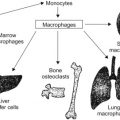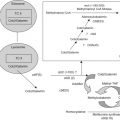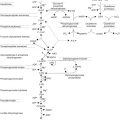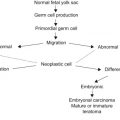Abstract
Acute myeloid leukemia (AML) accounts for approximately 20% of childhood leukemia, yet is responsible for a majority of the deaths from leukemia. Children present with a wide range of signs and symptoms, ranging from anemia to life-threatening coagulopathy, complications from tumor lysis syndrome or leukemic infiltration. Patients with AML are at an increased risk of infection and should receive prophylactic antimicrobials. Cytarabine, daunorubicin, and etoposide remain the backbone of AML therapy. Fludarabine, cytarabine, granulocyte colony-stimulating factor, and idarubicin (FLAG-IDA) are utilized for relapsed/refractory AML. Hematopoietic stem cell transplantation is recommended for high-risk and relapsed patients. Therapies targeting novel molecular and cytogenetic markers are under investigation. Acute promyelocytic leukemia, a unique subtype of AML, is treated with all-trans retinoic acid and arsenic trioxide, with very good response. Myeloid leukemia in Down syndrome is another unique subtype of AML; patients typically have a GATA1 mutation and have an excellent response to reduced intensity regimens. Methods with increased sensitivities are being utilized for the detection of occult disease below the level of morphologic detection, referred to as minimal residual disease (MRD). Treatment protocols utilize MRD to assess response to therapy and guide future therapy.
Keywords
Acute myeloid leukemia, acute promyelocytic leukemia, AML, APML, FLT-3, GATA-1, minimal residual disease, MRD, myeloid malignancy
Acute myelogenous leukemia (AML) is characterized by the abnormal proliferation and differentiation of myeloid precursors in the bone marrow. While the etiology of primary AML is unknown, certain predisposing factors can lead to secondary AML as discussed below. While AML is the less common of the two acute leukemias of childhood, it is responsible for most acute leukemia deaths.
Etiology and Predisposing Conditions
Development of AML is thought to follow a multihit hypothesis. An initial oncogenic mutation creates a “preleukemic” cell that eventually develops into a leukemic cell via a second promotional mutation. Genetic and molecular mutations resulting in AML are classified as Class I and Class II mutations as listed in Table 19.1 .
| Mechanism | Examples | |
|---|---|---|
| Class I mutations | Proliferative and/or survival advantage to cells, without altering cellular differentiation | RAS, FLT-3, KIT, CBL |
| Class II mutations | Impair differentiation and dysregulate apoptosis | RUNX1, MLL, PML/RARA |
Table 19.2 lists the predisposing conditions associated with an increased risk of developing AML.
- •
Fanconi anemia: Patients have a 50% risk of developing AML. They have increased toxicity from chemotherapy, necessitating protocol modifications.
- •
Severe congenital neutropenia: Patients have a 21% risk of developing AML, most often preceded by a mutation in the granulocyte colony-stimulating factor receptor gene. Partial or total loss of chromosome 7 occurs in half of the patients.
- •
Shwachman–Diamond syndrome (SDS): Patients have a 30% risk of developing AML associated with abnormalities of chromosome 7.
| Inherited conditions | Acquired conditions | Environmental exposures |
|---|---|---|
|
|
|
Therapy-related myelodysplastic syndrome and therapy-related AML (t-AML) typically present within 3–5 years after treatment but cases up to 10 years or more have been described. Patients with t-AML tend to have a worse prognosis than patients with de novo disease with identical cytogenetics. t-AML related to topoisomerase II inhibitors have a short latency (6–36 months).
- •
Epipodophyllotoxins: Exposure typically results in French–American–British (FAB) M4 or M5 AML and often involves a mixed lineage leukemia ( MLL ) gene rearrangement (11q.23).
- •
Anthracyclines: Often involves an MLL gene rearrangement.
- •
Alkylating agents: Often results in AML with poor-risk cytogenetics.
Twin concordance
- •
Concordance studies on identical twins show that an identical twin is twice as likely as the general population to develop leukemia if his/her twin developed leukemia before age 7.
- •
If the affected identical twin was diagnosed as an infant, the concordance rate is nearly 100%.
- •
Analysis of unique genomic fusion gene sequences of the leukemias suggests a common clonal origin.
Clinical Features
See Chapter 18 on ALL for some of the common clinical features that may occur in all cases of acute leukemia.
Children with AML may present with a wide range of signs and symptoms, ranging from fever, anemia, or thrombocytopenia to life-threatening coagulopathy or complications from extramedullary disease (EMD) resulting in organ dysfunction.
EMD consists of a collection of myeloblasts or immature myeloid cells outside of the bone marrow. It is seen in approximately 10–20% of patients with AML. It can occur as a myeloid sarcoma (MS), previously referred to as a chloroma, or as the presence of leukemic cells in the cerebrospinal fluid (CSF). The most common presentations are gingival hypertrophy, lymphadenopathy, and leukemia cutis. MS is also seen within the central nervous system (CNS) and the orbit, periorbital areas, and paraspinal areas. EMD typically occurs concurrently with AML but occasionally may present as the first manifestation, even before bone marrow involvement. Even in the absence of bone marrow involvement EMD should be treated using an AML protocol. EMD has been associated with t(8;21), inv(16), and 11q23 MLL rearrangements. CNS disease is associated with a high white blood cell (WBC) and is more often seen with M4 and M5 AML.
Diagnosis
Laboratory Studies
Blood count and bone marrow
- •
Leukocytosis: Median WBC count at diagnosis is 20,000/mm 3 .
- •
Approximately 20% of patients present with WBC count above 100,000/mm 3 .
- •
Auer rods, needle-shaped intracytoplasmic azurophilic inclusion bodies are often, but not always seen in AML, particularly in M2 or M3 AML.
- •
Anemia: Hemoglobin <9 g/dl in 50% of patients.
- •
Thrombocytopenia: Platelets <100,000/mm 3 in 75% of patients.
- •
The WHO classification of AML defines that 20% blasts are required for the diagnosis of AML, patients with clonal cytogenetic abnormalities including t(8;21) (q22;q22), inv(16) (p13;q22) or t(16;16) (p13;q22) and t(15;17) (q22;q12) are considered to have AML regardless of the blast percentage.
- •
Special bone marrow studies, which help in detailed cell classification, include: histochemistry, immunophenotying, and cytogenetics.
The morphologic features of myeloblasts and the cytochemical features of AML are shown in Tables 19.3 and 18.3 (see previous chapter), respectively.
| Characteristic | Lymphoblasts | Myeloblasts |
|---|---|---|
| Size | 10–20 mm | 14–20 mm |
| NUCLEUS | ||
| Shape | Round or oval | Round or oval |
| Chromatin | Smooth, homogeneous | Spongy, loose, finely developed meshwork |
| Nucleoli | 0–2 and indistinct | 2–5 and distinct “punched-out” |
| Nuclear membrane | Smooth, round | Irregular |
| Nuclear–cytoplasmic ratio | High | Low |
| CYTOPLASM | ||
| Color | Blue | Blue-gray |
| Amount | Thin rim | More abundant |
| Granules | Absent | Present |
| Auer rods | Absent | Present |
Cerebrospinal fluid (CSF) : The diagnosis of CSF leukemia is the same as described for ALL (see Chapter 18 ).
CNS involvement at diagnosis and at relapse is seen in 5–10% of pediatric AML patients. See Table 19.4 for factors associated with CNS leukemia. Unlike acute lymphoblastic leukemia (ALL), CNS disease in AML is not a factor within the AML risk group stratification because it does not affect overall survival (OS), although those with CNS disease have an increased incidence of isolated CNS relapse. Intrathecal (IT) chemotherapy is given to all patients, including those without any detectable CNS involvement. Patients with CNS involvement at diagnosis receive additional intensified IT chemotherapy consisting of weekly IT chemotherapy until blasts clear from the CSF and monthly thereafter until the end of therapy.
| Hyperleukocytosis |
| Monocytic leukemia (FAB M4 or M5, including M4eo with inv(16)) |
| MLL rearrangement |
| Younger age (<2 years) |
Coagulation profile : Decreased coagulation factors that frequently occur are hypofibrinogenemia, decreased levels of factors V, IX, and X.
Monitor for tumor lysis syndrome: The extent of electrolyte disturbances and degree of tumor lysis varies depending on the leukemic burden and rate of cell turnover. Tumor lysis syndrome occurs less frequently in AML than in ALL, and is more often seen in FAB M4 or M5 AML than other subtypes. Complete metabolic panel, including lactic dehydrogenase and uric acid should be sent at diagnosis (see Chapter 32 ).
Cardiac function assessment: Electrocardiogram and echocardiogram should be performed at baseline and with each cycle of chemotherapy to monitor for cardiotoxicity.
Infectious disease evaluation: Patients often present with fever, thought to be due to pyrogens released by leukemic cells and as an inflammatory response. Blood cultures should be drawn and antibiotics initiated (see Chapter 33 for details). Viral studies should be sent including: varicella antibody titer, cytomegalovirus antibody titer, herpes simplex antibody, and hepatitis antibody screening at baseline.
Classification of AML
Acute leukemia can be classified based on morphologic characteristics, cytochemical features, immunologic characteristics, and cytogenetic and molecular characteristics. Table 19.5 lists the WHO classification of acute myeloid leukemia and related neoplasms.
| ACUTE MYELOID LEUKEMIA AND RELATED NEOPLASMS |
|
Table 19.6 lists the FAB classification of AML.
|
FAB M5 and M7 are more common in early childhood, while older children are more likely to have FAB M 0 , M 1 , M 2 , and M 3 . AML in patients with Down syndrome (DS) is frequently associated with FAB M7 (megakaryoblastic leukemia).
Table 19.7 shows the WHO classification of acute leukemias of ambiguous lineage which are discussed below.
| Lineage | Marker |
|---|---|
| Myeloid |
|
| T lineage |
|
| B lineage |
|
The quantitative bone marrow criteria for the diagnosis of acute myeloblastic leukemia are summarized in Table 19.8 .
| Bone marrow cells | M1 (%) | M2 (%) | M4 (%) | M5 (%) | M6 (%) |
|---|---|---|---|---|---|
| BLASTS | |||||
| All nucleated cells | – | >30 | >30 | – | <30 or >30 |
| Nonerythroid cells | 90 | >30 | >30 | >80 b | >30 |
| Erythroblasts<all nucleated cells | – | <50 | <50 | – | >50 |
| Granulocytic component c <nonerythroid cells | <10 | >10 | >20 d | <20 | Variable |
| Monocytic component e <nonerythroid cells | <10 | <20 | >20 | >80 b | Variable |
Stay updated, free articles. Join our Telegram channel

Full access? Get Clinical Tree







